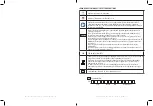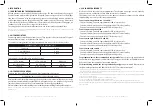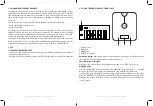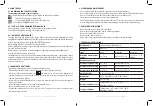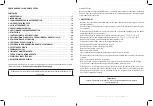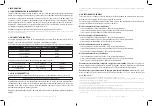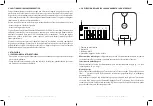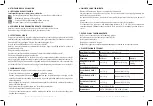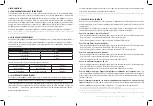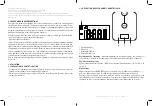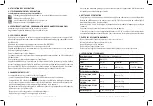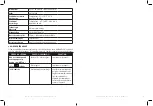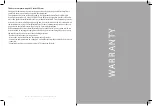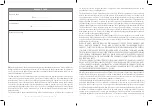
BewellConnect - BW-SCF5 - User Manual - 022017v1
BewellConnect - BW-SCF5 - User Manual - 022017v1
8
9
2. INFORMATION
2-1. UNDERSTANDING THE ENERGY BALANCE
All food provides calories and all calories provide energy. The human body uses this energy to
live, breathe and perform all daily activities. Generally, a man’s energy needs are 5 to 10% higher
than those of a woman
1
, with the exception of pregnant or breastfeeding women, whose daily
calorie requirements ensure the good health of the mother and baby. This energy is measured
in kilocalories (1 kilocalorie = 1000 calories). It is recorded in Kcal but by misuse of language, we
continue to use the term «calorie» instead of «kilocalorie.».
The energy balance represents the difference between caloric intake and expenditure.
Reference 1: Ferraro R, Lillioja S, Fontvieille AM, Rising R, Bogardus C, Ravussin E. Lower sedentary metabolic rate in women compared with
men. J Clin Invest. 1992 Sep;90(3):780-4.
2-2. MY ENERGY INTAKE
Your energy intake comes from the foods you eat. They provide calories in the form of 3 types of
macronutrients: proteins, carbohydrates and lipids.
To control your energy intake, it is important to know how many calories a food provides.
MACRONUTRIENTS / KCAL CONVERSION TABLE
1 g protein
4 kcals
1 g carbohydrates
4 kcals
1 g fat
9 kcals
For example, a 154 g fillet of white fish provides 255.2 kcals.
37.7 g protein
37.7 g x 4 kcal/g
150.8 kcals
0 g carbohydrates
0 g x 4 kcal/g
0 kcals
11.6 g fat
11.6 g x 9 kcal/g
104.4 kcals
2-3. MY ENERGY EXPENDITURE
You have two types of energy expenditure: basal metabolism and exercise.
Basal meta exercise = energy expended per day
Basal metabolism is the minimum energy the body needs to maintain vital functions. It can vary
greatly from one individual to another. Indeed, it depends on age, sex, weight, etc. It generally
represents between 60 and 70% of total metabolism (total energy expenditure).
Exercise includes sports such as walking to work, climbing stairs or walking to take public transport
2
.
Reference 2: Schofield, W. N. (1984). Predicting basal metabolic rate, new standards and review of previous work. Human nutrition. Clinical
nutrition, 39, 5-41.
2-4. CALORIE REQUIREMENTS
We do not all have the same calorie requirements. They depend on our age, our sex, our body
type, our exercise, and the time of day when calories were consumed.
That is why it is useless to start a diet or to set a quota of calories to consume per day without
really knowing your own specific calorie requirements.
You are a woman aged between 18 and 40
3
:
- You are sedentary: you need approximately 1900 calories per day.
- You are moderately active: you need approximately 2150 calories per day.
- You are active: you need approximately 2500 calories per day.
You are a woman aged over 40 :
- You are sedentary: you need approximately 1655 calories per day.
- You are moderately active: you need approximately 1855 calories per day.
- You are active: you need approximately 2110 calories per day.
You are a man aged between 18 and 40 :
- You are sedentary: you need approximately 2415 calories per day.
- You are moderately active: you need approximately 2670 calories per day.
- You are active: you need approximately 2965 calories per day.
You are a man aged over 40 :
- You are sedentary: you need approximately 2110 calories per day.
- You are moderately active: you need approximately 2365 calories per day.
- You are active: you need approximately 2680 calories per day.
For pregnant women, the recommended energy intake is: no extra energy requirement in
the first trimester, approximately 340 calories extra energy per day for the second trimester and
452 calories extra energy per day for the third trimester.
For breastfeeding women, the average extra daily energy is: approximately 330 calories for
the 0-6 months postpartum and 400 calories for the 7-12 months postpartum
4
.
- Sedentary means a lifestyle that includes only the physical activity of independent living.
- Moderately Active means a lifestyle that includes physical activity equivalent to walking about 1.5 to 3 miles per day at 3 to 4 miles per hour,
in addition to the activities of independent living.
-Active means a lifestyle that includes physical activity equivalent to walking more than 3 miles per day at 3 to 4 miles per hour, in addition
to the activities of independent living.
Estimates for females do not include women who are pregnant or breastfeeding.
Reference 3: According to the dietary guidelines for americans 2015-2020.
Available on : https://health.gov/dietaryguidelines/2015/resources/2015-2020_Dietary_Guidelines.pdf (Last visited 5th Sept 2016)
Reference 4: Institute of Medicine. Dietary Reference Intakes: The Essential Guide to Nutrient Requirements. Washington: The National Aca-
demies Press; 2006.


